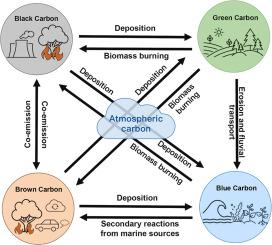Interactions between black, brown, blue and green carbon from terrestrial to marine ecosystems: A critical review
引用次数: 0
Abstract
Black and brown carbon are byproducts of the incomplete combustion of biomass or fossil fuels. These light-absorbing aerosols influence climate by altering the radiative balance through the absorption and scattering of sunlight, exacerbating global climate change. Their subsequent deposition on terrestrial and marine environments affects surface albedo, snow and ice melt, and biogeochemical processes, leading to further environmental consequences. In contrast, green and blue carbon refer to carbon stored in terrestrial vegetation and marine ecosystems, respectively. These ecosystems play a crucial role in mitigating climate change by sequestering atmospheric carbon; however, they are increasingly threatened by climatic disturbances, anthropogenic activities, and environmental degradation, which can compromise their carbon storage potential. Black and brown carbon interact with green and blue carbon pools through multiple pathways, including wildfire dynamics, atmospheric deposition, and fluvial transport. Additionally, these interactions contribute to climate-driven feedback loops that influence carbon fluxes and storage capacity. While black and brown carbon emissions pose significant threats to green and blue carbon sinks by accelerating climate change and ecosystem destabilization, recent studies estimate that a percentage of BC produced from biomass burning can be stabilized as recalcitrant carbon in soils for centuries to millennia, and BC buried in deep marine sediment may persist for over 20,000 years. This persistence underlies its potential role in long-term carbon sequestration, particularly through biochar application in soils and natural deposition in deep-ocean sediments. Understanding the complex and multifaceted interactions between black, brown, green, and blue carbon is critical for developing comprehensive climate mitigation strategies.

从陆地到海洋生态系统的黑色、棕色、蓝色和绿色碳之间的相互作用:一个重要的回顾
黑碳和棕色碳是生物质或化石燃料不完全燃烧的副产品。这些吸光气溶胶通过吸收和散射阳光来改变辐射平衡,从而加剧全球气候变化,从而影响气候。它们随后沉积在陆地和海洋环境中,影响地表反照率、冰雪融化和生物地球化学过程,导致进一步的环境后果。相比之下,绿色碳和蓝色碳分别指陆地植被和海洋生态系统中储存的碳。这些生态系统通过封存大气中的碳,在减缓气候变化方面发挥着至关重要的作用;然而,它们越来越多地受到气候干扰、人为活动和环境退化的威胁,这可能会损害它们的碳储存潜力。黑色和棕色碳通过多种途径与绿色和蓝色碳库相互作用,包括野火动力学、大气沉积和河流运输。此外,这些相互作用有助于形成气候驱动的反馈循环,影响碳通量和储存能力。虽然黑色和棕色碳排放加速了气候变化和生态系统的不稳定,对绿色和蓝色碳汇构成了重大威胁,但最近的研究估计,生物质燃烧产生的一定比例的碳可以作为顽固性碳在土壤中稳定存在数百年至数千年,而埋在深海沉积物中的碳可能会持续存在2万年以上。这种持久性是其在长期固碳方面的潜在作用的基础,特别是通过在土壤中应用生物炭和在深海沉积物中自然沉积。了解黑碳、棕碳、绿碳和蓝碳之间复杂和多方面的相互作用,对于制定全面的气候减缓战略至关重要。
本文章由计算机程序翻译,如有差异,请以英文原文为准。
求助全文
约1分钟内获得全文
求助全文

 求助内容:
求助内容: 应助结果提醒方式:
应助结果提醒方式:


